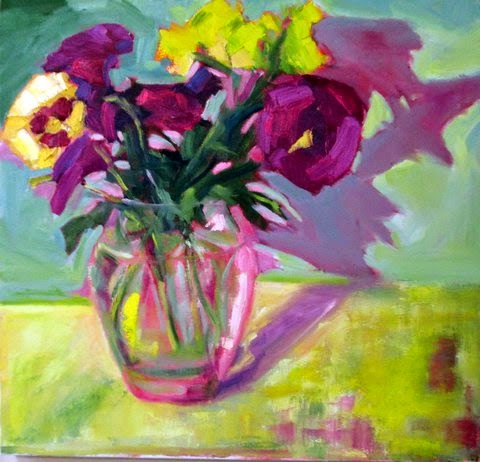The Sisters check out the MFA
At the Museum of Fine Arts in Boston there is a show of selections of Jamie Wyeth's paintings and some small sculptures from the last 30 years or so. I was there a few weeks ago with three of my four sisters, looking at this show and a show of old quilts that were all about color and geometry. The quilts have left the building, and if you missed that show you missed several rooms of very high level geometric abstractions done by women in the 1930 with very few other creative outlets and probably no formal training. Pretty amazing, really. The Wyeth show is up until December 28th and I think it's worth seeing. The Monhegan Island works really appealed to me, naturally, having spent some time there painting myself. His view is distinct and energetic.
James (“Jamie”) Browning Wyeth (born July 6, 1946) is a contemporary American realist painter, son of Andrew Wyeth, and grandson ofN.C. Wyeth. He was raised in Chadds Ford Township, Pennsylvania, and is artistic heir to the Brandywine School tradition, painters who worked in the rural Brandywine River area of Delaware and Pennsylvania, portraying its people, animals, and landscape.
 |
| Jamie Wyeth, The Sea, Watched 30" x 48" |
In the 1960s Jamie purchased the Lobster Cove property on Monhegan Island in Maine, which had previously been owned by Rockwell Kent, the famed American painter of modernist wilderness landscapes admired by his grandfather and succeeding generations. Jamie has painted many of the local people on Monhegan Island. He and his wife have a home at Chadds Ford, Pennsylvania on the Brandywine. In the 1990s his parents, Betsy and Andrew Wyeth, sold Jamie the Tenants Harbor Light on Southern Island in Maine that they had owned since 1978. As it provides him the solitude and subject matter he most enjoys for his work, most of his painting is done at Tenants Harbor; the rest is done at Chadds Ford. The light station has been inactive since 1933. The tower that held the lantern was reconstructed for his studio.
 |
| Cat Bates of Monhegan 1995 |
There is a room of portraits from Wyeth's time in New York as a young man at the Factory with Andy Warhol. His Warhol portraits are insightful, they are beautiful, and they surprised me in their take on the vulnerability of Warhol. The Nureyev portraits date from this time as well. There are small, intricate sculptural dioramas of Warhol's dining room with figures that are shown here for the first time. The room made me want to learn beyond the legend what that era with the Factory was like.
 |
| Nureyev |
 |
| Portrait of Andy Warhol 1976 |
In the 1970s, Wyeth painted Andy Warhol, Rudolf Nureyev and Arnold Schwarzenegger. Wyeth and Andy Warhol exchanged portraits of each other. A 1976 show featuring the portraits, at the Coe Kerr Gallery in New York, has been credited with reviving the popularity of the genre, after a period of being eclipsed by Abstract Expressionism. Curator Wendy Wick Reaves has said of the pair: "They were considered polar opposites. Andy was called the Patriarch of Pop, and Jamie was called Prince of Realism. ... Both had become enormously famous but also had endured extraordinary critical censure for the way their art was done. And they had a lot of interests in common: They collected Americana; they were interested in death and morbidity. They really got along splendidly." In Portrait of Andy Warhol (1976), Warhol seems to be "caught off guard without his personal persona". Nureyev's portrait reflects an intense man. Wyeth was fascinated by Nureyev, and found him to have an animal-like presence and strength that is captured in the portrait. The portrait above was described as Mr. Nureyev as he looked leaving the theater.
And there are the animal paintings. Wyeth's dogs, sheep, goats, chickens all have an almost human presence. He recalls NC Wyeth in these works to my mind.
 |
| The Islander 1976 |
Since the 1970s, Wyeth has often painted on corrugated cardboard, and now uses "archival" versions of the surface. He likes the rough striated effect it gives to his paintings, and he has also portrayed the material with great fidelity in depictions on conventional canvas, such as the painting 10W30 (1981), depicting a pair of chickens nesting in a discarded carton that once had held 10W30 grade engine oil. He also uses thick, opaque watercolor pigments, straight from the tube, creating effects similar to oil paints.







Comments
Post a Comment